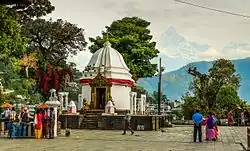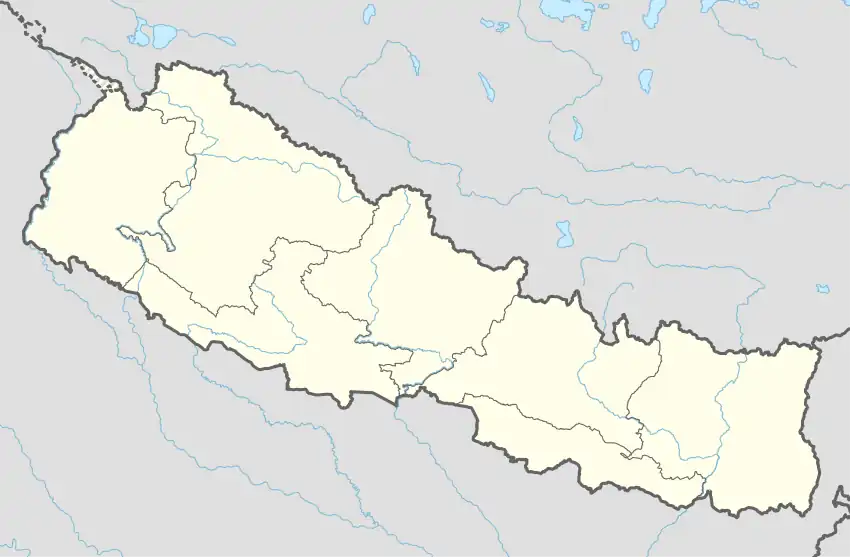| Bindhyabasini Temple | |
|---|---|
बिन्ध्यबासिनी मन्दिर | |
 Bindhyabasini Temple | |
| Religion | |
| Affiliation | Hinduism |
| District | Kaski |
| Deity | Bindhyabasini, Kali, Bhagawati |
| Festivals | Fulpati, Navadurga, Shivaratri |
| Governing body | Bindhyabasini Dharmik Chettra Bikash Samiti (बिन्ध्यबासिनी धार्मिक छेत्र बिकाश समिति) |
| Location | |
| Location | Pokhara |
| State | Gandaki |
| Country | Nepal |
 Shown within Nepal | |
| Geographic coordinates | 28°14′16″N 83°59′03″E / 28.2378°N 83.9842°E |
| Architecture | |
| Type | ShikharaShikhara |
| Creator | Siddhi Narayan Shah or Khadgaman Malla |
| Completed | c 1760 |
| Specifications | |
| Temple(s) | 1 |
| Monument(s) | 1 |
| Elevation | 915 m (3,002 ft) |
| Website | |
| http://bindhyabasinitemple.com/ | |

The Bindhyabasini Temple (Nepali: बिन्ध्यबासिनी मन्दिर) is the oldest temple in the city of Pokhara, Nepal and is located in Ward No. 2, Miruwa.[1] It regularly attracts a large number of locals, Nepalis from across the country and foreigners alike.[2] The main temple is devoted to the goddess Bindhyabasini, a Bhagawati who is the incarnation of Kali. There are smaller temples of the goddess Saraswati, Shiva, Hanuman, and Ganesha on the premises. The temple is situated atop a small hill and can be accessed via stone staircases on the East and North East.
The views of the Himalayas from the North of the temple are breathtaking while from the South one can see the expanse of Pokhara city.
History
The temple was established circa 1760s.[3] King Girvan Yuddha Bikram Shah, the then king of Nepal appointed Kahindra Padhya Poudel in June 1815 AD as temple priest replacing Harivamsha Padhya. Its stated that the priest could use the Guthi Lands endowed for the temple to perform regular and ceremonial puja.[4]
Legend on the establishment of the temple
The king of Kaski, Sidddhi Narayan Shah or the king of Parbat Khadgaman Malla saw a dream about establishing a temple for the goddess Bindhyabasini. He had his men go to Bindhyachal Parbat (currently in Uttar Pradesh, India) to bring back a statue of the goddess. The men when returning set up camp for a night at the current location of the temple. When they woke up the next morning to resume their journey, they found they couldn't lift the statue from the ground. When informed of the situation, the king directed his people to establish the temple, hence the beginning of Bindhyabasini Temple.
Common belief about goddess Bindhyabasini
Goddess Bindhyabasini is commonly believed by the residents of Miruwa that she is the replacement for the eighth child (Lord Krishna) of Devaki and Vasudeva. When Kansa tries to kill the child, who's been exchanged, she, who's herself a Devi disappears and is in fact goddess Bindhyabasini.
Architecture
There's no information about the style of the original temple (and it is assumed to have been rebuilt at some point) but the current temple is in Shikhara style. Shikhara style of temple architecture is considered older than the much prevalent Pagoda architecture.
Two golden metal lions stand erect beside the temple gate and metal gong-bells eerie in the background frequently. The Bindhyabasini temple in a glance is a simple yet striking monument. The local “Dharmik Chhetra Bikas Samiti” regulates the temple.
Buildings in the premises
- Saraswati Mandir
- Hanuman Mandir
- Shiva Mandir
- Bindhyabasini Sanskrit Vidyalaya
- Book store
- Vishnu Mandir
- Ganesha Mandir
- Jogi Paati
Temple Area Management
The temple is currently managed by Bindhyabasini Dharmik Chettra Bikash Samiti [5] which has carried out a number of improvements and upgraded the area. Examples include establishment of Gurukul bhawan, upgrades to various smaller temples in the area, upgrade of Bindhyabasini park below the temple area etc.
History
The temple was built in 1842 B.S. in 47 ropanis of land. The legend of Bindhyabasini temple begins when the king of Kaski, Siddhi Narayan Malla or the king of Parbat, Khadgaman Malla dreamt about establishing a temple for the goddess. So, he ordered some of his men to bring back a statue of the goddess from present Uttar Pradesh of India.
During their journey, the men set up camps at the current temple location. However, the next morning they could not move on their journey because the deity could not be lifted from the camps. So, eventually, the temple was established in Mohariya Tole of Pokhara.
Since then this place has been a hub for worshippers. The meaning of ‘Bindhya” means incarnation of goddess and “Basini” means the dweller of a place.[6]
Accessibility
A lift with a capacity of 12 people was installed in the temple premises,[7] and inaugurated by the President of Nepal on March 7, 2019. The lift is primarily used by disabled pilgrims and seniors.
A Senior Citizens Friendship Center was established in January 2016.[8] The facility allows for a meeting point for senior citizens, provides food every day to those who attend and arranges for talks on a variety of subjects.
Noted Fact
Most of Pokhara city was destroyed in the fire of 1949 and the fire was allegedly started in Bindhyabasini temple while performing an offering which later spread out of control.[9]
Temple in the News
See also
References
- ↑ . 15 June 2020 https://web.archive.org/web/20200615050624/http://pokharamun.gov.np/sites/pokharamun.gov.np/files/Ward%202.jpg. Archived from the original on 15 June 2020. Retrieved 15 June 2020.
{{cite web}}: Missing or empty|title=(help) - ↑ "Soaring Indian arrivals boost Pokhara tourism". 14 June 2020. Archived from the original on 14 June 2020. Retrieved 14 June 2020.
- ↑ Adhikari, Jagannath (2017). Pokhara: Urbanization, Environment and Development. Amazon: Kindle Edition. pp. Loc 86.
- ↑ Regmi, Mahesh (1 December 1974). "Regmi Research Collections". Regmi Research Collections. 42: 1.
- ↑ "Lift Inauguration at Bindhyabasini Temple Premises". 14 June 2020. Archived from the original on 14 June 2020. Retrieved 14 June 2020.
- ↑ Himalaya, Altitude (15 August 2020). "Bindhyabasini Temple Pokhara Nepal | History and Location of Bindabasini". Altitude Himalaya. Retrieved 10 August 2021.
- ↑ "President Bhandari inaugurates lift | eAdarsha.com – English Version". 14 June 2020. Archived from the original on 14 June 2020. Retrieved 14 June 2020.
- ↑ "My Republica - Chief Secy Subedi inaugurates Senior Citizens Friendship Center". 15 June 2020. Archived from the original on 15 June 2020. Retrieved 15 June 2020.
- ↑ Reed, Dave; McConnachie, James (7 November 2013). The Rough Guide to Nepal. Rough Guides UK. ISBN 978-1-4093-6034-6.
- ↑ "Royal couple visits Bindhyabasini". The Himalayan Times. 27 March 2004. Retrieved 14 June 2020.
- ↑ "Visiting Indian army chief visits Bindhyabasini temple". 14 June 2020. Archived from the original on 14 June 2020. Retrieved 14 June 2020.
- ↑ "Navadurga Festival kicks off in Pokhara". 15 June 2020. Archived from the original on 15 June 2020. Retrieved 15 June 2020.